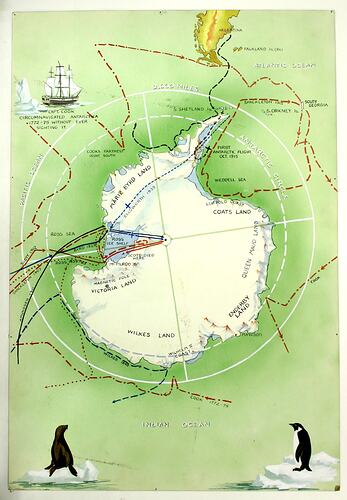People have long been fascinated by the frozen continent, for diverse reasons: national leaders were once interested in its strategic possibilities, scientists have always wanted to study its unique environment, and today tourists seek to experience its strange beauty.
The first maritime explorer to cross the Antarctic circle was James Cook in 1773. Cook's first two voyages to the Pacific Ocean were largely motivated by the desire to discover and chart the 'great Southern Continent'.
A century of maritime exploration followed before the first party landed on the Antarctic continent in 1895, led by Australian resident Carstens Borchgrevink. This began the so-called 'Heroic Era' of Antarctic exploration as European nations mounted expeditions to lay claim to Antarctic territory. Australians participated in expeditions under British explorers Robert Scott and Ernest Shackleton in the first decade of the twentieth century. In 1911, Australia also sent its own expedition under Douglas Mawson. These expeditions were all organized on an ad-hoc basis.
After World War II Australia established an ongoing program of Antarctic exploration under the leadership of Dr Phillip Law. This led to the establishment of Mawson Station in 1954, the oldest continually occupied station in Antarctica.
A significant event in Antarctic history was the International Geophysical Year in 1957. Many countries sent expeditions to Antarctica for the first time, and at the height of the Cold War scientists from countries including Australia, the Soviet Union and the USA were able to work cooperatively. This renewed interest in Antarctica prompted a number of countries to question the territorial claims that had been made by Australia and other countries. Years of international negotiations led to the development of the Antarctic treaty system, whereby territorial claims were put on hold, and all nations agreed to manage Antarctic affairs by consensus for peaceful purposes. Australia took a major role in these negotiations.
The Antarctic treaty system initially left open the question of commercial exploitation of Antarctica. There had long been interest in such exploitation. Many of the first inhabitants of the sub-Antarctic regions were sealers and whalers. Other commercial intrusions were more unusual - Douglas Mawson named MacRobertson Land after the major sponsor of his expedition. Through the twentieth century, the attention of many turned to the potential resources of Antarctica, particularly its mineral reserves. Thus it was a remarkable achievement in the 1980s and 1990s when the Antarctic Treaty was extended to regulate fishing, provide protection for native flora and fauna, and to completely ban mining. Again, Australia was pivotal in the negotiation of these protocols.
Today Antarctica continues to be the home of scientific research, highlighted by the International Polar Years of 2007-2009 while the strange beauty of Antarctica is also drawing tourists in ever-increasing numbers.
More Information
-
Keywords
-
Authors
-
Article types


